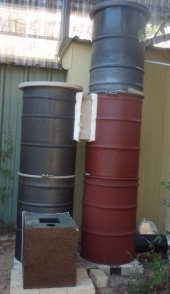Hi Michael,
I guess the gas flow through the flues will stop once the temp inside drops below what's needed to keep things moving and I suspect (though don't know) that a drop below this critical temp will tend to lessen or mitigate an on-going all-out leakage of heat from the stack without the need for a damper. However, I have seen some builds on Youtube where folks do close off the entry to the feed-tube when not in use. I'd imagine this doesn't need to be a perfect seal and would stop the leakage of a lot of heat. Probably a whole lot cheaper than adding a damper too.
Edited to add: Just saw your location. Ok, with you being in Alaska perhaps the external temp. is so low that you'll never hit the point where the stack stops pulling till the heat has been robbed from the bench. In which case I'd think a well sealed cover over the feed tube would probably be enough.
BTW, you might find this article comparing bells and flues interesting:
http://blog.dragonheaters.com/wood-heat-storage-flues-vs-bells/.


